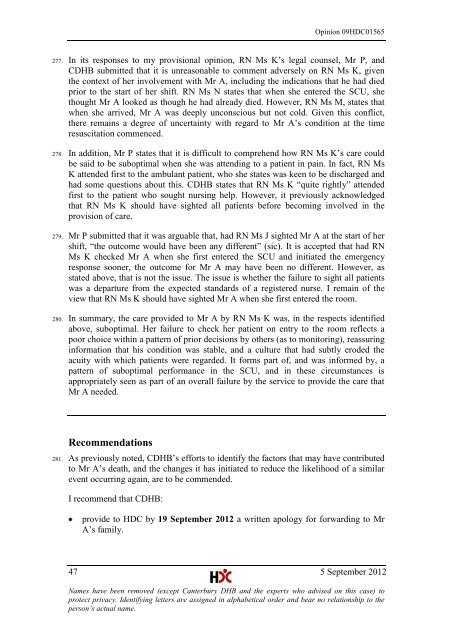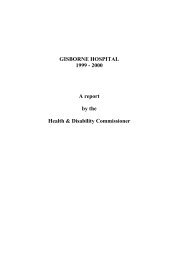09HDC01565 - Health and Disability Commissioner
09HDC01565 - Health and Disability Commissioner
09HDC01565 - Health and Disability Commissioner
Create successful ePaper yourself
Turn your PDF publications into a flip-book with our unique Google optimized e-Paper software.
Opinion <strong>09HDC01565</strong><br />
277. In its responses to my provisional opinion, RN Ms K‘s legal counsel, Mr P, <strong>and</strong><br />
CDHB submitted that it is unreasonable to comment adversely on RN Ms K, given<br />
the context of her involvement with Mr A, including the indications that he had died<br />
prior to the start of her shift. RN Ms N states that when she entered the SCU, she<br />
thought Mr A looked as though he had already died. However, RN Ms M, states that<br />
when she arrived, Mr A was deeply unconscious but not cold. Given this conflict,<br />
there remains a degree of uncertainty with regard to Mr A‘s condition at the time<br />
resuscitation commenced.<br />
278. In addition, Mr P states that it is difficult to comprehend how RN Ms K‘s care could<br />
be said to be suboptimal when she was attending to a patient in pain. In fact, RN Ms<br />
K attended first to the ambulant patient, who she states was keen to be discharged <strong>and</strong><br />
had some questions about this. CDHB states that RN Ms K ―quite rightly‖ attended<br />
first to the patient who sought nursing help. However, it previously acknowledged<br />
that RN Ms K should have sighted all patients before becoming involved in the<br />
provision of care.<br />
279. Mr P submitted that it was arguable that, had RN Ms J sighted Mr A at the start of her<br />
shift, ―the outcome would have been any different‖ (sic). It is accepted that had RN<br />
Ms K checked Mr A when she first entered the SCU <strong>and</strong> initiated the emergency<br />
response sooner, the outcome for Mr A may have been no different. However, as<br />
stated above, that is not the issue. The issue is whether the failure to sight all patients<br />
was a departure from the expected st<strong>and</strong>ards of a registered nurse. I remain of the<br />
view that RN Ms K should have sighted Mr A when she first entered the room.<br />
280. In summary, the care provided to Mr A by RN Ms K was, in the respects identified<br />
above, suboptimal. Her failure to check her patient on entry to the room reflects a<br />
poor choice within a pattern of prior decisions by others (as to monitoring), reassuring<br />
information that his condition was stable, <strong>and</strong> a culture that had subtly eroded the<br />
acuity with which patients were regarded. It forms part of, <strong>and</strong> was informed by, a<br />
pattern of suboptimal performance in the SCU, <strong>and</strong> in these circumstances is<br />
appropriately seen as part of an overall failure by the service to provide the care that<br />
Mr A needed.<br />
Recommendations<br />
281. As previously noted, CDHB‘s efforts to identify the factors that may have contributed<br />
to Mr A‘s death, <strong>and</strong> the changes it has initiated to reduce the likelihood of a similar<br />
event occurring again, are to be commended.<br />
I recommend that CDHB:<br />
provide to HDC by 19 September 2012 a written apology for forwarding to Mr<br />
A‘s family.<br />
47 5 September 2012<br />
Names have been removed (except Canterbury DHB <strong>and</strong> the experts who advised on this case) to<br />
protect privacy. Identifying letters are assigned in alphabetical order <strong>and</strong> bear no relationship to the<br />
person’s actual name.
















